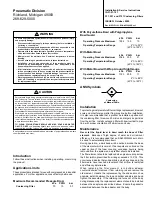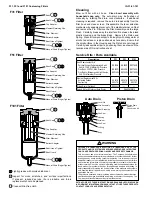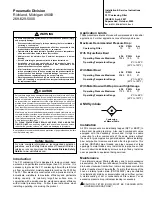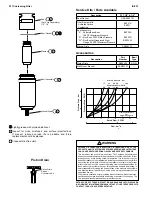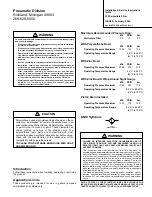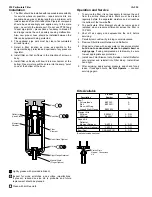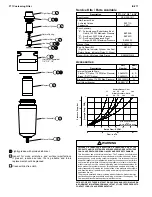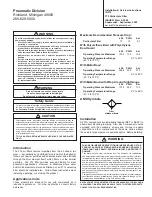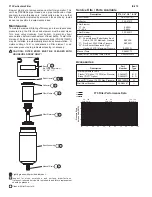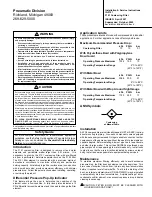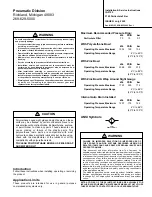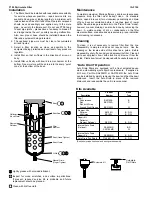
!
Pneumatic Division
Richland, Michigan 49083
269-629-5000
Introduction
The F71 coalescing filter is designed to remove oil and water
aerosols, and particulate matter larger than 0.01 micron. It is
necessary to provide the F71 coalescing filter with pre-filtered air
from a particulate / moisture separator such as the F75 filter. The
F71 filter element is constructed with a precision matrix of borosilicate
microfibers to maximize efficiency and particulate holding capacity.
Its relatively large fiber surface area, in conjunction with a small
pore size, provides maximum efficiency with minimal pressure drop.
Follow these instructions when installing, operating, or servicing the
product.
Differential Pressure Pop-Up Indicator
This feature allows the user to determine the condition of the
element under a flow condition. A fully risen piston indicates (12
PSI differential across the element) the need to change the filter
element.
Application Limits
These products are intended for use with compressed air in industrial
applications. For other applications, consult factory before use.
Maximum Recommended Pressure Drop:
kPa PSIG
bar
Coalescing Filter
70
10
0.7
With Polyurethane Bowl with Polyethylene
Bowl Guard
kPa PSIG
bar
Operating Pressure Maximum
1034
150
10
Operating Temperature Range
4°C to 52°C
(40°F to 125°F)
With Metal Bowl
kPa PSIG
bar
Operating Pressure Maximum
2068
300
21
Operating Temperature Range
4°C to 82°C
(40°F to 180°F)
With Metal Bowl with Wrap Around Sight Gauge
kPa PSIG
bar
Operating Pressure Maximum
1723
250
17
Operating Temperature Range
4°C to 66°C
(40°F to 150°F)
ANSI Symbols
Installation
All FRL components are individually tapped (NPT or BSPP) to allow
direct mounting to piping. Also, each component comes equipped
with the necessary screws and O-rings to enable connection to other
components of the same series without the need for pipe nipples
or special adaptors. Before installing, blow out pipe line to remove
scale and other foreign matter. This unit has DRYSEAL pipe threads;
use pipe compound or tape sparingly to male threads only. Install
units in pipe line so that flow is in direction indicated by arrows on top
of body. Install as near as possible to equipment being serviced.
Maintenance
To maintain maximum filtering efficiency, and to avoid excessive
pressure drop, the filter bowl and element must be kept clean. Turn
drain valve clockwise, from bottom, to drain any bowl accumulation
before it reaches level of lower baffle. To aid in the draining of the
bowl, an internal automatic drain (PN SAF105MD) may be installed
to automatically drain bowl accumulation. A visible coating of dirt or
condensate on filter element, or an excessive pressure drop, indicates
cleaning is necessary.
CAuTION: FILTER BOwL MuST BE CLEANED wITh
hOuSEhOLD SOAP ONLY!
WARNING
To avoid unpredictable system behavior that can cause personal injury
and property damage:
• Disconnect electrical supply (when necessary) before installation,
servicing, or conversion.
• Disconnect air supply and depressurize all air lines connected to this
product before installation, servicing, or conversion.
• Operate within the manufacturer’s specified pressure, temperature,
and other conditions listed in these instructions.
• Medium must be moisture-free if ambient temperature is below
freezing.
• Service according to procedures listed in these instructions.
• Installation, service, and conversion of these products must be
performed by knowledgeable personnel who understand how
pneumatic products are to be applied.
• After installation, servicing, or conversion, air and electrical supplies
(when necessary) should be connected and the product tested for
proper function and leakage. If audible leakage is present, or the
product does not operate properly, do not put into use.
• Warnings and specifications on the product should not be covered by
paint, etc. If masking is not possible, contact your local representative
for replacement labels.
!
!
CAUTION
Polyurethane bowls, being transparent and tough, are ideal for use with Filters
and Lubricators. They are suitable for use in normal industrial environments, but
should not be located in areas where they could be subjected to direct sunlight,
an impact blow, nor temperatures outside of the rated range. As with most
plastics, some chemicals can cause damage. Polyurethane bowls should not
be exposed to chlorinated hydrocarbons, ketones, esters and certain alcohols.
They should not be used in air systems where compressors are lubricated with
fire-resistant fluids such as phosphate ester and di-ester types.
Metal bowls are recommended where ambient and/or media conditions are not
compatible with polyurethane bowls. Metal bowls resist the action of most such
solvents, but should not be used where strong acids or bases are present or
in salt laden atmospheres. Consult the factory for specific recommendations
where these conditions exist.
TO CLEAN POLYURETHANE BOWLS USE MILD SOAP AND WATER
ONLY! DO NOT
use cleansing agents such as acetone, benzene, carbon
tetrachloride, gasoline, toluene, etc., which are damaging to this plastic.
Bowl guards are recommended for added protection of polyurethane bowls where
chemical attack may occur.
Coalescing
w/ Manual Drain
Installation & Service Instructions
IS-F71
F71 Coalescing Filter
ISSUED: April, 2007
Supersedes: October, 2005
Doc. #ISF71, ECN #070214, Rev. 2
Safety Guide
For more complete information on recommended application
guidelines, see the Safety Guide section of Pneumatic Division
catalogs or you can download the
Pneumatic Division Safety
Guide
at: www.wattsfluidair.com


